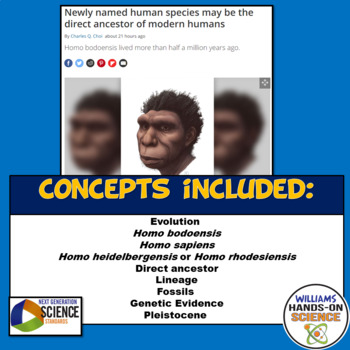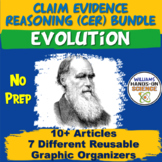CER Evolution Claim Evidence Reasoning NGSS MS-LS4-1 HS-LS4-1 Digital
- Zip
Also included in
- Students learn about various current events and discoveries in Evolution through Claim Evidence Reasoning. You get 10+, 30-40 minute NO PREP resources that are great for English Language Arts, Sub Plans, reinforcing content, application of content to the real world and the NGSS Science and EngineeriPrice $35.00Original Price $61.00Save $26.00
Description
Students learn how Scientists have named a new species that may have been the direct ancestor of modern humans through a C.E.R. (Claim Evidence Reasoning) graphic organizer. This is great for getting your students to explain phenomena in a meaningful way and it allows you as the instructor to adequately assess their understanding of concepts. The students figure out what the "Claim" is in the article, they then use data that supports the claim in the "Evidence" section, draw visual evidence and then explain why the evidence supports the claim in the "Reasoning" section.
The article has the following concepts:
Evolution
Homo bodoensis
Homo sapiens
Homo heidelbergensis or Homo rhodesiensis
Direct ancestor
Lineage
Fossils
Genetic Evidence
Pleistocene
Save money and Take a look at my CER Mega bundle!
Save money and Take a look at my Evolution Bundle
What you get with this resource:
-2 graphic organizer PDF's
-2 Google Ready graphic organizers
-Anchor chart to scaffold and support students with CER
-Article Link in Google Slideshow
-Google Classroom Tutorial
Related Products:
Geologic Time Scale Card Sort NGSS MS-LS4-1 Google Ready Graphic Organizer
Evolution LS4.A LS4.B LS4.C Google Ready Growing Bundle Natural Selection
6th 7th or 8th Grade NGSS Genetic Variation/Growth and Development of Organisms
Evolution Claim Evidence Reasoning MS-LS4-1 HS-LS4-2 HS-LS4-1 MS-LS4-2
This is great for a current event, sub plan, homework, critical thinking, scaffolding and/or reinforcement of concepts!
You get a CER graphic organizer, an editable key, the article, tips for CER and the link to the website in the article.
NGSS for Middle School:
LS4.A: Evidence of Common Ancestry and Diversity
•The collection of fossils and their placement in chronological order (e.g., through the location of the sedimentary layers in which they are found or through radioactive dating) is known as the fossil record. It documents the existence, diversity, extinction, and change of many life forms throughout the history of life on Earth. (MS-LS4-1)
•Anatomical similarities and differences between various organisms living today and between them and organisms in the fossil record, enable the reconstruction of evolutionary history and the inference of lines of evolutionary descent. (MS-LS4-2)
NGSS for High School:
LS4.A: Evidence of Common Ancestry and Diversity
•Genetic information provides evidence of evolution. DNA sequences vary among species, but there are many overlaps; in fact, the ongoing branching that produces multiple lines of descent can be inferred by comparing the DNA sequences of different organisms. Such information is also derivable from the similarities and differences in amino acid sequences and from anatomical and embryological evidence. (HS-LS4-1)
NGSS Science and Engineering Practices:
SEP's Asking Questions and Defining Problem:
Students at any grade level should be able to ask questions of each other about the texts they read, the features of the phenomena they observe, and the conclusions they draw from their models or scientific investigations.
Engaging in Argument from Evidence:
In 9–12 builds on K–8 experiences and progresses to using appropriate and sufficient evidence and scientific reasoning to defend and critique claims and explanations about the natural and designed world(s). Arguments may also come from current scientific or historical episodes in science.
CCC's: Patterns
Observed patterns of forms and events guide organization and classification, and they prompt questions about relationships and the factors that influence them.
TERMS OF USE
• All rights reserved by Williams Hands On Science, Inc.
• This product is to be used by the original purchaser only.
• Intended for classroom and personal use only.
• Copying for more than one teacher, classroom, department, school, or school system is prohibited.
• This product may not be distributed or displayed digitally for public view.
• Failure to comply is a copyright infringement and a violation of the Digital Millennium Copyright Act (DMCA).
If there are any errors or questions, please contact me through TpT or email me at:
williamshandsonscience@gmail.com
Thank you for taking a look!
Please follow me on TpT for new products and check me out on Instagram for my products in action!






